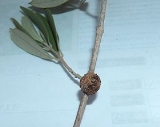
Pseudomonas savastanoi
Encyclopedia
Pseudomonas savastanoi is a Gram-negative
plant
pathogenic bacterium that infects a variety of plant
s. It was once considered a pathovar
of Pseudomonas syringae
, but following DNA-relatedness studies, it was instated as a new species.
The pathovar of greatest economical significance is Pseudomonas savastanoi pv. oleae, which causes the disease olive
knot. Symptoms include formation of galls on infected trees; tumour formation is induced by indoleacetic acid biosynthesis by the bacteria, in a similar manner to the well-studied crown gall pathogen, Agrobacterium tumefaciens
.
canker.
Pseudomonas savastanoi pv. nerii attacks oleander
.
Pseudomonas savastanoi pv. oleae causes olive
knot.
Pseudomonas savastanoi pv. phaseolicola attacks Phaseolus
(bean) plants
Gram-negative
Gram-negative bacteria are bacteria that do not retain crystal violet dye in the Gram staining protocol. In a Gram stain test, a counterstain is added after the crystal violet, coloring all Gram-negative bacteria with a red or pink color...
plant
Plant
Plants are living organisms belonging to the kingdom Plantae. Precise definitions of the kingdom vary, but as the term is used here, plants include familiar organisms such as trees, flowers, herbs, bushes, grasses, vines, ferns, mosses, and green algae. The group is also called green plants or...
pathogenic bacterium that infects a variety of plant
Plant
Plants are living organisms belonging to the kingdom Plantae. Precise definitions of the kingdom vary, but as the term is used here, plants include familiar organisms such as trees, flowers, herbs, bushes, grasses, vines, ferns, mosses, and green algae. The group is also called green plants or...
s. It was once considered a pathovar
Pathovar
A pathovar is a bacterial strain or set of strains with the same or similar characteristics, that is differentiated at infrasubspecific level from other strains of the same species or subspecies on the basis of distinctive pathogenicity to one or more plant hosts.Pathovars are named as a ternary or...
of Pseudomonas syringae
Pseudomonas syringae
Pseudomonas syringae is a rod shaped, Gram-negative bacterium with polar flagella. It is a plant pathogen which can infect a wide range of plant species, and exists as over 50 different pathovars, all of which are available to legitimate researches via international culture collections such as the...
, but following DNA-relatedness studies, it was instated as a new species.
The pathovar of greatest economical significance is Pseudomonas savastanoi pv. oleae, which causes the disease olive
Olive
The olive , Olea europaea), is a species of a small tree in the family Oleaceae, native to the coastal areas of the eastern Mediterranean Basin as well as northern Iran at the south end of the Caspian Sea.Its fruit, also called the olive, is of major agricultural importance in the...
knot. Symptoms include formation of galls on infected trees; tumour formation is induced by indoleacetic acid biosynthesis by the bacteria, in a similar manner to the well-studied crown gall pathogen, Agrobacterium tumefaciens
Agrobacterium tumefaciens
Agrobacterium tumefaciens is the causal agent of crown gall disease in over 140 species of dicot. It is a rod shaped, Gram negative soil bacterium...
.
Pathovars
Pseudomonas savastanoi pv. fraxini causes ashAsh tree
Fraxinus is a genus flowering plants in the olive and lilac family, Oleaceae. It contains 45-65 species of usually medium to large trees, mostly deciduous though a few subtropical species are evergreen. The tree's common English name, ash, goes back to the Old English æsc, while the generic name...
canker.
Pseudomonas savastanoi pv. nerii attacks oleander
Oleander
Nerium oleander is an evergreen shrub or small tree in the dogbane family Apocynaceae, toxic in all its parts. It is the only species currently classified in the genus Nerium. It is most commonly known as oleander, from its superficial resemblance to the unrelated olive Olea, but has many other...
.
Pseudomonas savastanoi pv. oleae causes olive
Olive
The olive , Olea europaea), is a species of a small tree in the family Oleaceae, native to the coastal areas of the eastern Mediterranean Basin as well as northern Iran at the south end of the Caspian Sea.Its fruit, also called the olive, is of major agricultural importance in the...
knot.
Pseudomonas savastanoi pv. phaseolicola attacks Phaseolus
Phaseolus
Phaseolus is a genus in the family Fabaceae of about fifty plant species, all native to the Americas.At least four of the species have been domesticated since pre-Columbian times for their beans. Most prominent among these is the common bean, P...
(bean) plants

